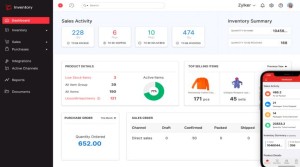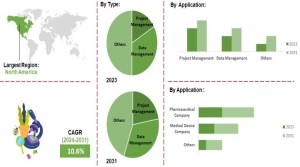Percent Error Calculator in Scientific Exploration
Learn how this digital tool simplifies the complex process, taking observed and true values to calculate percentage errors effortlessly.
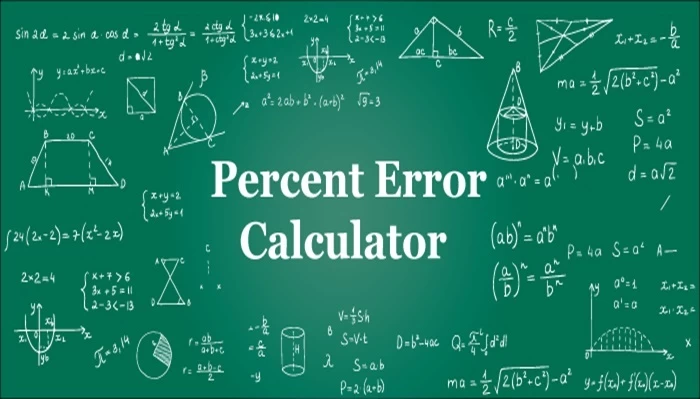
Imagine you're in chemistry lab, meticulously measuring substances for a groundbreaking experiment. Every drop, every gram counts. But what if your measurements are slightly off? This is where percent error becomes crucial. It's the yardstick that tells you just how close or far your experimental results are from the true values. Percent error is a measure used in various fields to assess the accuracy of a measurement or calculation. It is calculated by taking the absolute difference between the observed value and the true or accepted value, dividing that difference by the true value, and then multiplying by 100 to express it as a percentage.
In professional settings, percent error serves as a valuable tool to evaluate the reliability of experimental or calculated results. A low percent error indicates a close agreement between the measured or calculated value and the expected value, suggesting a high degree of precision. On the other hand, a high percent error signifies a significant discrepancy, highlighting potential errors in the measurement process or the underlying assumptions of a calculation. Therefore, understanding and carefully managing percent error is crucial for maintaining the integrity of scientific, engineering, or analytical endeavors, as it helps identify and rectify inaccuracies, contributing to more reliable and meaningful outcomes.
Percent Error Calculator
In this digital age, where every calculation is at our fingertips, why not make percent error calculations a breeze too? Enter the percent error calculator, a nifty tool that streamlines the process and reduces the chance of human error. The calculator takes the observed value and the true value as inputs, effortlessly crunching the numbers to provide you with the percentage error. No more scratching your head over manual calculations; let technology do the heavy lifting while you focus on the science.
Components of the Percent Error Calculator
-
Observed Value
This is the result you obtain through your experiment or measurement. It's the data you collect in the field or the lab, representing your best attempt to quantify a phenomenon.
-
True Value
Often considered the holy grail of measurements, the true value is the theoretically perfect measurement. It's what you'd obtain under ideal conditions, free from any external influences or experimental limitations. The percent error calculator takes these two values and reveals the degree of accuracy in your experiment, helping you fine-tune your methods for more precise outcomes.
Methods to Minimize Percent Error
Calibration
Regularly calibrate your instruments to ensure accuracy. Even the most advanced tools can drift over time, and recalibrating keeps your measurements on point.
Multiple Trials
Conducting experiments numerous times and averaging the results helps mitigate the impact of outliers, enhancing the overall accuracy of your findings.
Quality Assurance
Implement stringent quality control measures in your experiments. This includes meticulous record-keeping, standardized procedures, and thorough peer reviews.
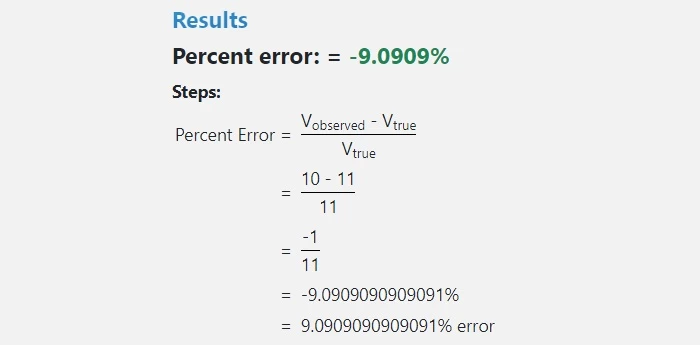
Real Life Applications of Percent Error Calculator
Science Experiments
Find yourself doing a chemistry experiment, and you measure the weight of a substance. The percent error helps you see how accurate your measurement is compared to the known or expected value. This is important to ensure the reliability of your experiment.
Manufacturing
In a factory, workers might use a percent error calculator to check the accuracy of the dimensions of products being produced. This ensures that the items meet the required specifications and quality standards.
Medical Tests
When doctors perform medical tests, they often compare the actual results with the expected values. Percent error can be used to evaluate how close the test results are to the established norms, providing insight into the accuracy of the diagnostic process.
Construction
Architects and builders use measurements to construct buildings. A percent error calculator can help them assess how closely the actual measurements of a building match the intended design, preventing potential structural issues.
Weather Forecasting
Meteorologists predict weather conditions using various models and data. Percent error can be applied to assess the accuracy of their predictions by comparing forecasted values with the actual observed weather conditions.
Education
Teachers might use a percent error calculator to grade tests and assignments. Suppose a student's answer is different from the expected one. In that case, the percent error helps quantify the deviation and provides feedback on the accuracy of the student's understanding.
Economics
Economists analyzing economic forecasts or financial models can use percent error to gauge how well predictions align with actual economic data. This aids in refining models and improving the accuracy of economic projections.
Sports Performance
Coaches and athletes can use percent error to evaluate how close an athlete's performance is to the targeted goals or records. This assists in adjusting training programs to enhance performance. For a diverse range of calculators, make sure to explore CoolCalculator and discover handy tools for various calculations.
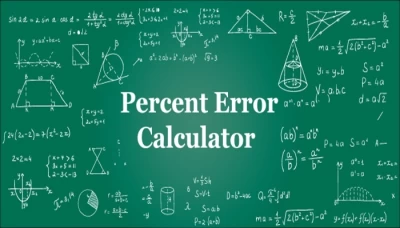
Imagine you're in chemistry lab, meticulously measuring substances for a groundbreaking experiment. Every drop, every gram counts. But what if your measurements are slightly off? This is where percent error becomes crucial. It's the yardstick that tells you just how close or far your experimental results are from the true values. Percent error is a measure used in various fields to assess the accuracy of a measurement or calculation. It is calculated by taking the absolute difference between the observed value and the true or accepted value, dividing that difference by the true value, and then multiplying by 100 to express it as a percentage.
In professional settings, percent error serves as a valuable tool to evaluate the reliability of experimental or calculated results. A low percent error indicates a close agreement between the measured or calculated value and the expected value, suggesting a high degree of precision. On the other hand, a high percent error signifies a significant discrepancy, highlighting potential errors in the measurement process or the underlying assumptions of a calculation. Therefore, understanding and carefully managing percent error is crucial for maintaining the integrity of scientific, engineering, or analytical endeavors, as it helps identify and rectify inaccuracies, contributing to more reliable and meaningful outcomes.
Percent Error Calculator
In this digital age, where every calculation is at our fingertips, why not make percent error calculations a breeze too? Enter the percent error calculator, a nifty tool that streamlines the process and reduces the chance of human error. The calculator takes the observed value and the true value as inputs, effortlessly crunching the numbers to provide you with the percentage error. No more scratching your head over manual calculations; let technology do the heavy lifting while you focus on the science.
Components of the Percent Error Calculator
-
Observed Value
This is the result you obtain through your experiment or measurement. It's the data you collect in the field or the lab, representing your best attempt to quantify a phenomenon.
-
True Value
Often considered the holy grail of measurements, the true value is the theoretically perfect measurement. It's what you'd obtain under ideal conditions, free from any external influences or experimental limitations. The percent error calculator takes these two values and reveals the degree of accuracy in your experiment, helping you fine-tune your methods for more precise outcomes.
Methods to Minimize Percent Error
Calibration
Regularly calibrate your instruments to ensure accuracy. Even the most advanced tools can drift over time, and recalibrating keeps your measurements on point.
Multiple Trials
Conducting experiments numerous times and averaging the results helps mitigate the impact of outliers, enhancing the overall accuracy of your findings.
Quality Assurance
Implement stringent quality control measures in your experiments. This includes meticulous record-keeping, standardized procedures, and thorough peer reviews.
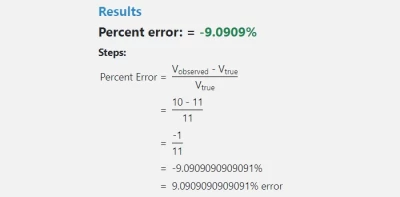
Real Life Applications of Percent Error Calculator
Science Experiments
Find yourself doing a chemistry experiment, and you measure the weight of a substance. The percent error helps you see how accurate your measurement is compared to the known or expected value. This is important to ensure the reliability of your experiment.
Manufacturing
In a factory, workers might use a percent error calculator to check the accuracy of the dimensions of products being produced. This ensures that the items meet the required specifications and quality standards.
Medical Tests
When doctors perform medical tests, they often compare the actual results with the expected values. Percent error can be used to evaluate how close the test results are to the established norms, providing insight into the accuracy of the diagnostic process.
Construction
Architects and builders use measurements to construct buildings. A percent error calculator can help them assess how closely the actual measurements of a building match the intended design, preventing potential structural issues.
Weather Forecasting
Meteorologists predict weather conditions using various models and data. Percent error can be applied to assess the accuracy of their predictions by comparing forecasted values with the actual observed weather conditions.
Education
Teachers might use a percent error calculator to grade tests and assignments. Suppose a student's answer is different from the expected one. In that case, the percent error helps quantify the deviation and provides feedback on the accuracy of the student's understanding.
Economics
Economists analyzing economic forecasts or financial models can use percent error to gauge how well predictions align with actual economic data. This aids in refining models and improving the accuracy of economic projections.
Sports Performance
Coaches and athletes can use percent error to evaluate how close an athlete's performance is to the targeted goals or records. This assists in adjusting training programs to enhance performance. For a diverse range of calculators, make sure to explore CoolCalculator and discover handy tools for various calculations.
Conversation
Latest Blogs
© Blog CoolCalculator, Explore CoolCalculator, your destination for the latest insights, tips, and updates on the world of online calculators. Stay informed and make your calculations smarter with our blog. ,
Designed
by Saad Media Team , Team Lead M.Rizwan Akhtar




